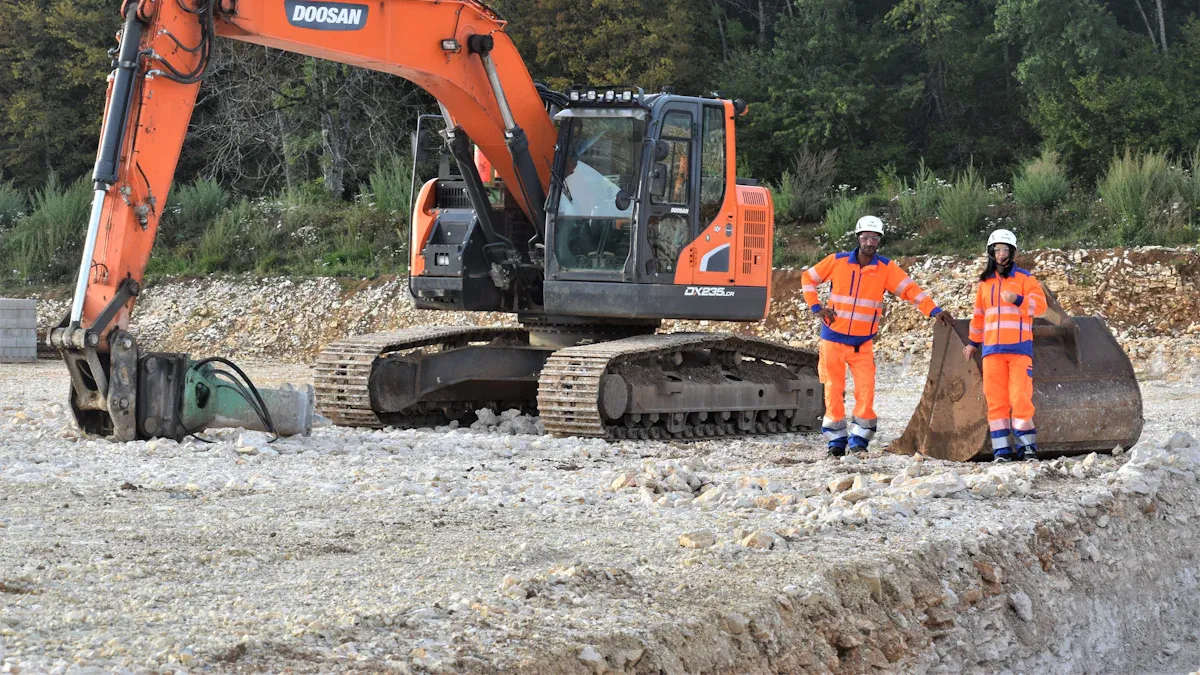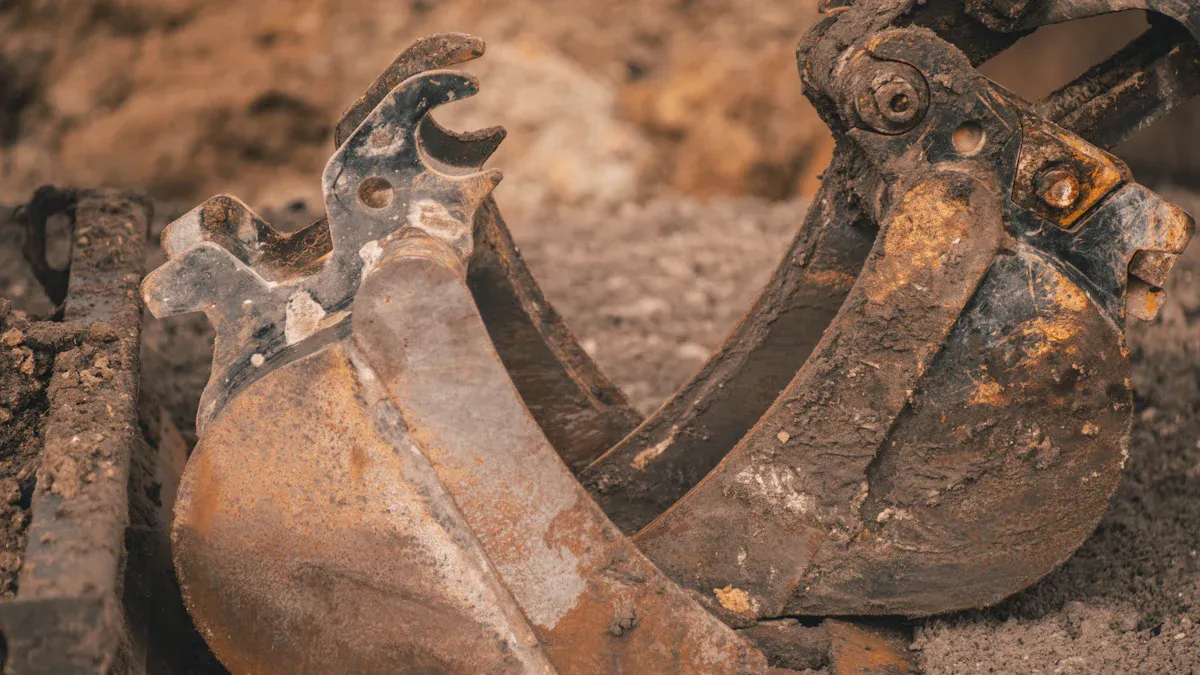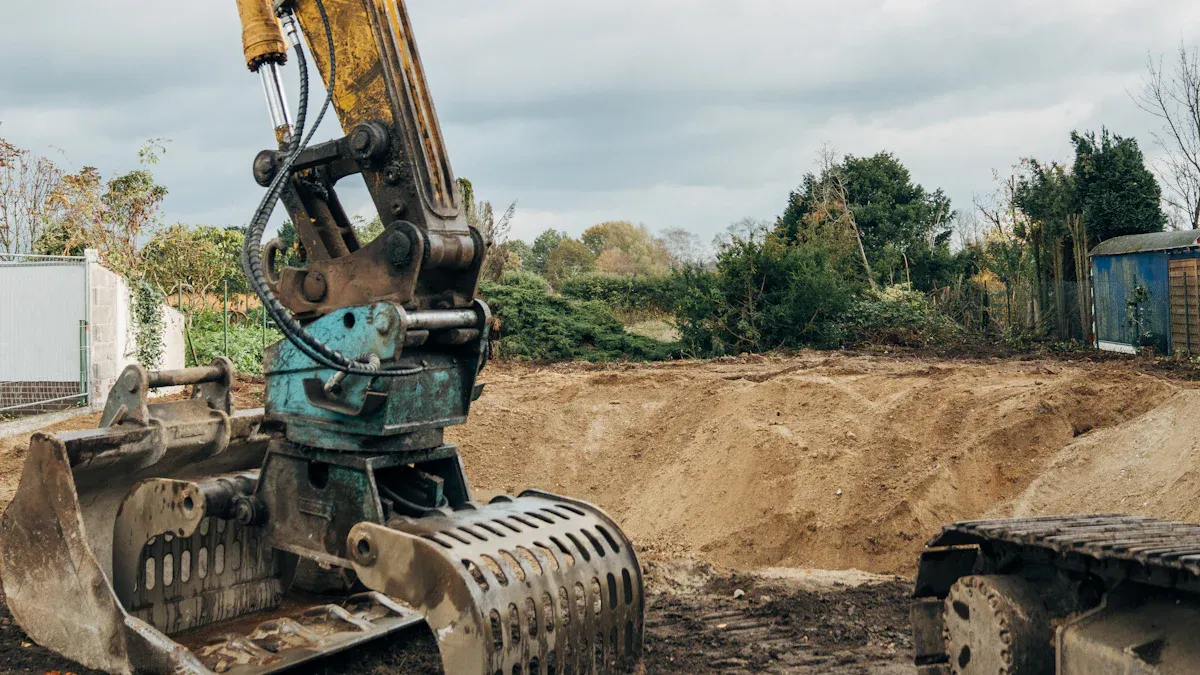
Selecting the right bucket tooth pins for mining excavators directly impacts equipment strength and reliability. Research shows a 34.28% improvement in effectiveness after optimizing the bucket tooth adapter, bucket pin and lock, and bucket pin and lock sleeve of excavator. The table below highlights key performance metrics for high-wear bucket tooth pins:
| Parameter | Value | Impact |
|---|---|---|
| Maximum stress on bucket tooth pin | 209.3 MPa | Safe stress level, reduced fracture risk |
| Deformation | 0.0681 mm | Durable under heavy loads |
| Safety factor | 3.45 | Meets safety standards |
Key Takeaways
- Choose the right bucket tooth pins by identifying your excavator’s pin system and matching pins to the brand and model to ensure a secure fit and reliable performance.
- Measure pin and tooth pocket sizes carefully using proper tools to avoid fit problems and extend the life of your equipment.
- Maintain and inspect pins regularly to reduce downtime, lower maintenance costs, and keep your mining excavator safe and efficient.
Why Bucket Tooth Pins for Mining Excavators Matter
Performance and Efficiency
Bucket tooth pins for mining excavators play a vital role in maximizing machine output. When operators select high-quality pins and locks, they see less downtime and lower maintenance costs. The right materials, such as Hardox alloy steel with Chromium, Niobium, Vanadium, and Boron, help reduce wear and extend service life. Optimized tooth designs also lower stress and deformation, which improves bucket filling and reliability.
Operators in different industries report measurable gains when using advanced bucket tooth pin systems. For example, urban pipe gallery projects see a 40% reduction in vibration and better digging response. In tunnel excavation, machines run for 72 hours straight without lubrication failure. Offshore wind projects show no pitting after six months in harsh conditions. These results highlight the importance of choosing the right pins.
| Performance Metric | Impact on Mining Excavator Output |
|---|---|
| Reduced Downtime | Fewer failures and less unscheduled maintenance |
| Lower Maintenance Costs | Less labor and fewer parts replaced |
| Extended Equipment Life | Durable design protects investments |
| Energy Efficiency | Improved power transmission lowers fuel use |
| Faster Installation | Hammerless systems save time |
| Output per Hour | More material moved due to reliable pins |
| Cost per Ton | Lower costs from reduced downtime and maintenance |
| Availability Rate | Higher uptime with secure pin and lock designs |
| Average Fuel Use per Machine | Better fuel efficiency with optimized systems |
| Average Loading Time | Faster cycles with reliable teeth |
| Percentage Uptime | Increased reliability from durable pins |
| Production Rate (BCM) | Higher hourly output through improved pin performance |
| Waste per Ton | Less material loss with precise, durable designs |
Safety and Equipment Longevity
Properly maintained bucket tooth pins for mining excavators help prevent accidents and extend equipment life. Operators who follow best practices see fewer failures and safer job sites.
- Regular maintenance of tooth retention systems prevents tooth loss during operation.
- Tooth loss can damage adaptors and reduce digging efficiency, leading to expensive repairs.
- Checking fastener torque helps avoid loose pins and failures.
- Rotating teeth on a schedule spreads wear and extends component life.
- Daily inspections based on wear, not just time, keep machines safe and reliable.
These steps show that using and maintaining the correct pins supports both safety and long-term equipment value.
Step 1: Identify Your Bucket Tooth System for Mining Excavators
Side Pin vs. Top Pin Systems
Mining excavators use two main types of bucket tooth retention systems: side pin and top pin. Each system has unique features that affect installation, maintenance, and performance.
- Side Pin Systems
Side pin systems secure the bucket tooth to the adapter using a pin inserted from the side. This design allows for quick removal and replacement. Operators often choose side pin systems for their simplicity and speed during maintenance. The pin and retainer sit horizontally, making them easy to access in the field. - Top Pin Systems
Top pin systems use a pin that enters from the top of the tooth and adapter. This setup provides a strong, vertical hold. Many heavy-duty mining excavators rely on top pin systems for extra security in demanding conditions. The vertical orientation helps resist forces from digging and lifting.
Tip: Always check the pin orientation before ordering replacements. Using the wrong type can lead to poor fit and equipment damage.
Technical studies and industry documentation highlight the importance of choosing the right system. Research shows that the number and position of teeth, along with the pin type, influence digging efficiency and tooth wear. Leading manufacturers recommend specific pin systems based on soil conditions and operational needs.
Recognizing Your Current Setup
Identifying the correct bucket tooth system on your mining excavator ensures safe and efficient operation. Operators should start by inspecting the bucket and tooth assembly.
- Visual Inspection
Look at the way the pin secures the tooth to the adapter.- If the pin enters from the side, you have a side pin system.
- If the pin enters from the top, you have a top pin system.
- Check for Manufacturer Labels
Many buckets have labels or stamped markings near the tooth assembly. These markings often indicate the system type and compatible pin sizes. - Consult Technical Documentation
Review the excavator’s manual or maintenance guide. Manufacturers provide diagrams and part numbers for each system. Some advanced monitoring solutions, such as those described in ShovelMetrics™ documentation, use sensors and AI to track tooth wear and detect missing teeth. These systems help operators identify the exact pin type and replacement schedule, reducing downtime and improving safety. - Ask Your Maintenance Team
Experienced technicians can quickly identify the system based on past repairs and replacements.
Note: Proper identification of your bucket tooth system prevents installation errors and ensures the right fit for bucket tooth pins for mining excavators.
A clear understanding of your current setup supports better maintenance planning. It also helps operators follow industry best practices for tooth spacing and arrangement, which can improve digging performance and extend equipment life.
Step 2: Match Bucket Tooth Pins for Mining Excavators to Brand and Model
Checking Manufacturer Specifications
Operators must always check the manufacturer’s specifications before selecting new pins. Each excavator model has unique requirements for pin size, material, and locking system. Equipment manuals provide detailed diagrams and part numbers. These resources help users avoid mismatches that can lead to costly downtime or equipment damage.
Ningbo Digtech (YH) Machinery Co.,Ltd. recommends reviewing both the bucket and tooth assembly documentation. This ensures that the selected pin matches the original design. Operators should also look for labels or stamped markings on the bucket. These markings often indicate compatible pin types and sizes. When in doubt, contacting the manufacturer or a trusted supplier can prevent installation errors.
Tip: Always keep a record of previous pin replacements. This practice helps maintenance teams track wear patterns and select the best replacement parts.
Common Brand Compatibility
Compatibility depends on matching the pin and lock system to the specific excavator model and its working environment. Some manufacturers, such as Hensley and Volvo, design systems that fit multiple brands. Others, like Caterpillar, tailor their pins to specific models. Operators should consult equipment manuals or reach out to Ningbo Digtech (YH) Machinery Co.,Ltd. for guidance on fitment.
Material quality and design innovations play a key role in performance and longevity. Forged pins, made from heat-treated alloy steel, offer superior wear resistance and toughness. Cast pins are lighter and more cost-effective but may not last as long in heavy-duty mining. Manufacturer reputation matters as well. Industry experience, customer reviews, and certifications like ISO reflect product quality and support.
- Always match pins to the excavator’s brand and model.
- Consider the operational environment and material quality.
- Choose suppliers with proven reliability and after-sales support.
No formal studies confirm universal compatibility across all brands. Operators must rely on manufacturer guidance and trusted suppliers to ensure the right fit.
Step 3: Measure Bucket Tooth Pin and Retainer Sizes Accurately

Tools Needed for Measurement
Accurate measurement starts with the right tools. Operators should gather a digital caliper, a steel ruler, and a micrometer. These tools help measure both length and diameter with high precision. A clean work surface prevents dirt from affecting the results. Safety gloves protect hands during handling. For best results, operators should also have a notepad to record measurements and a flashlight to inspect hard-to-see areas.
Tip: Always calibrate measuring tools before use. This step ensures reliable results and prevents costly mistakes.
Measuring Pin Length and Diameter
Measuring pin length and diameter requires careful attention to detail. Operators should remove the pin from the assembly and clean it thoroughly. Place the pin on a flat surface. Use a digital caliper to measure the outer diameter at several points along the pin. This method checks for wear or deformation. Next, measure the total length from end to end using a steel ruler or caliper.
Engineering guidelines recommend strict tolerances for mining applications. For example, pin diameters often range from 0.8 mm to 12 mm, with a tolerance of +/- 0.0001 inches. Lengths typically fall between 6.35 mm and 50.8 mm, with a tolerance of +/- 0.010 inches. The table below summarizes key measurement standards:
| Aspect | Details |
|---|---|
| Pin Diameter | 0.8 – 12 mm (tolerance: +/- 0.0001 in) |
| Pin Length | 6.35 – 50.8 mm (tolerance: +/- 0.010 in) |
| Fit Types | Press fit (tight), Slip fit (loose) |
| End Styles | Chamfer (beveled), Radius (rounded, metric only) |
| Standards | ANSI/ASME B18.8.2, ISO 8734, DIN EN 28734 |
Operators should compare their measurements to manufacturer specifications. This practice ensures a secure fit and reliable performance in mining environments.
Step 4: Double-Check Tooth Pocket Dimensions for Mining Excavators
Inspecting the Tooth Pocket
Operators should always begin by cleaning the tooth pocket. Dirt and debris can hide cracks or worn areas. A flashlight helps spot any damage inside the pocket. They should look for signs of wear, such as rounded edges or uneven surfaces. Measuring the pocket width and depth with a caliper ensures accuracy. If the pocket shows deep grooves or distortion, replacement may be necessary.
Tip: Regular inspection prevents unexpected failures and keeps the excavator running smoothly.
Ensuring a Secure Fit
A secure fit between the pin, tooth, and pocket is essential for safe operation. Engineering studies using Finite Element Method (FEM) show that the right shape and size reduce stress and improve durability. Reinforced locking mechanisms help prevent the tooth from coming loose. High-strength materials, such as 40Cr or 45# steel, increase wear resistance and hardness. Operators should check that the locking system matches the excavator brand to avoid installation problems.
- Optimized design lowers stress concentrations and extends component life.
- Reliable tooth lock systems reduce maintenance costs and downtime.
- Proper fit minimizes operational wear and prevents premature failure.
Failure analyses of mechanical parts reveal that poor fit and weak locking systems often cause cracks and fractures. Selecting the right materials and ensuring precise dimensions help avoid these issues. Operators who double-check pocket dimensions and fit can expect longer-lasting components and fewer repairs.
Step 5: Confirm Compatibility and Order Bucket Tooth Pins for Mining Excavators
Reviewing All Specifications
Operators should review every specification before placing an order. They need to check the pin length, diameter, and material. The tooth pocket dimensions must match the pin size. Operators should compare their measurements with the manufacturer’s documentation. This step helps prevent fit issues and equipment damage. They should also confirm the locking system type and ensure it matches the excavator’s requirements. Reviewing all details reduces the risk of downtime and costly mistakes.
Tip: Double-checking specifications saves time and money during installation.
Ordering from Trusted Suppliers
Choosing a reliable supplier ensures consistent quality and smooth operations. Many customers report positive experiences with suppliers who value professionalism and responsibility. These suppliers follow strict principles, such as “quality the basic, trust the first and management the advanced.” They maintain stable customer relationships by providing attentive support, even to small companies. Customers appreciate warm receptions, thorough discussions, and smooth cooperation. Suppliers often resolve problems quickly and offer valuable suggestions. Discounts may be available without sacrificing product quality, which helps balance cost and quality control.
- Suppliers respect every customer, regardless of company size.
- They provide sincere service and maintain good credit.
- Customers experience smooth cooperation after detailed discussions.
- Problems are resolved quickly, building trust for future orders.
Operators who select trusted suppliers for bucket tooth pins for mining excavators can expect reliable products and ongoing support.
Troubleshooting Bucket Tooth Pins for Mining Excavators
Dealing with Fit Problems
Operators sometimes face fit problems when installing new pins. A pin that feels too loose or too tight can cause trouble during operation. Loose pins may rattle or fall out, while tight pins can make installation difficult and increase stress on the assembly.
To address these issues, operators should:
- Clean all contact surfaces before installation.
- Measure both the pin and the tooth pocket again to confirm correct sizing.
- Check for any debris or damage inside the pocket.
- Use only pins that match the manufacturer’s specifications.
Tip: If a pin does not fit as expected, avoid forcing it. Forcing can damage the bucket or the pin itself.
A table of common fit issues and solutions can help:
| Problem | Possible Cause | Solution |
|---|---|---|
| Loose fit | Worn pocket or pin | Replace worn parts |
| Tight fit | Wrong size or debris | Re-measure, clean, or replace |
| Pin won’t seat | Misalignment | Realign components |
What to Do If Pins Wear Out Quickly
Rapid wear of bucket tooth pins for mining excavators often signals deeper problems. Wear analysis reports show that abrasive wear, impact forces, and material inconsistencies can all speed up pin failure. Maintenance records often reveal that uneven hardness or brittle layers, such as adiabatic shear layers, weaken the pin.
Operators should review maintenance logs and inspect failed pins for cracks or plastic deformation. Hardness testing can uncover weak spots caused by poor casting or lack of heat treatment. These findings point to the need for better materials, improved heat treatment, or design changes.
To reduce rapid wear, operators can:
- Choose pins made from high-quality, heat-treated alloy steel.
- Request design upgrades that address specific mining conditions.
- Work with suppliers to customize wear protection solutions.
Note: Regular inspections and detailed maintenance records help identify wear patterns early, allowing for targeted improvements and longer pin life.
Quick Reference Chart: Bucket Tooth Pins for Mining Excavators by Brand and Size

Selecting the correct pin size and type for each brand ensures a secure fit and reliable performance. The following tables provide a quick reference for common bucket tooth pins for mining excavators by leading brands. Operators should always verify part numbers and measurements with manufacturer documentation.
Caterpillar Bucket Tooth Pins for Mining Excavators
| Pin Part Number | Compatible Tooth Series | Pin Length (mm) | Pin Diameter (mm) |
|---|---|---|---|
| 8E4743 | J200 | 70 | 13 |
| 8E4744 | J250 | 80 | 15 |
| 8E4745 | J300 | 90 | 17 |
| 8E4746 | J350 | 100 | 19 |
Operators should match the pin to the correct tooth series for best results.
Komatsu Bucket Tooth Pins for Mining Excavators
| Pin Part Number | Tooth Model | Pin Length (mm) | Pin Diameter (mm) |
|---|---|---|---|
| 09244-02496 | PC200 | 70 | 13 |
| 09244-02516 | PC300 | 90 | 16 |
| 09244-02518 | PC400 | 110 | 19 |
Hitachi Bucket Tooth Pins for Mining Excavators
- 427-70-13710 (EX200): 70 mm length, 13 mm diameter
- 427-70-13720 (EX300): 90 mm length, 16 mm diameter
Always check the tooth model before ordering replacement pins.
Volvo Bucket Tooth Pins for Mining Excavators
| Pin Part Number | Tooth Model | Pin Length (mm) | Pin Diameter (mm) |
|---|---|---|---|
| 14530544 | EC210 | 70 | 13 |
| 14530545 | EC290 | 90 | 16 |
Doosan Bucket Tooth Pins for Mining Excavators
- 2713-1221 (DX225): 70 mm length, 13 mm diameter
- 2713-1222 (DX300): 90 mm length, 16 mm diameter
Tip: Keep a chart of pin sizes in the maintenance area for quick reference.
Selecting the right bucket tooth pins for mining excavators delivers measurable benefits:
- Faster cycle times and fewer passes increase productivity.
- Reduced wear and tear lower maintenance costs.
- Cost savings come from less downtime and fuel use.
- Improved safety and operator comfort support efficient operations.
For expert support, contact the team today.
FAQ
How often should operators inspect bucket tooth pins for mining excavators?
Operators should inspect bucket tooth pins daily. Regular checks help prevent unexpected failures and keep equipment running safely.
What materials work best for bucket tooth pins in mining applications?
High-quality alloy steel, such as Hardox or 40Cr, offers excellent wear resistance and durability. These materials extend service life in harsh mining environments.
Can operators reuse old bucket tooth pins after removal?
Reusing old pins increases the risk of failure. Always install new pins to ensure a secure fit and maintain equipment safety.
Post time: Jul-08-2025